Friday, July 27
• Full Moon (exact at 4:20 p.m. EDT). Full Moon is opposition Moon, so it shines with brilliant Mars, which is just a day past its opposition.
Mars right now is 143 times farther from us than the Moon (and it's twice as large). Its surface is covered with rusty dark brown dust compared to the Moon's very dark gray dust. So why do they look orange and white in our night sky? Because they're illuminated brilliantly, by direct sunlight, while the rest of the nighttime scenery around us (to which our eyes adapt) is much dimmer.
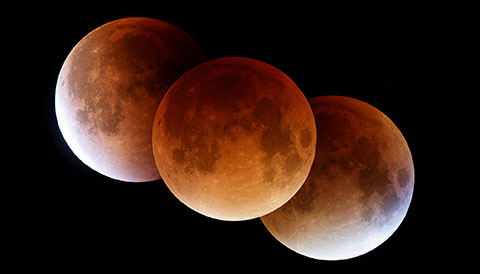
• Total eclipse of the Moon, but not for North America! (or Hawai`i). The best views will be from Europe, Africa, and much of Asia. This is the longest total lunar eclipse of the 21st century, with totality lasting 1 hour 43 minutes. Next to reddish Mars, the Moon will turn from white to (presumably) very red, then back to white.
The basic timetable: Partial eclipse begins at 18:24 UT, total eclipse begins 19:30 UT, total eclipse ends 21:13 UT, partial eclipse ends 22:19 UT July 27. Totality happens in twilight or evening for Europe, eastern Brazil, and West Africa; late at night from the Middle East through India; and around dawn for Southeast Asia and much of China, Indonesia, and Australia.
Article with details and world map: Red Moon Meets Red Planet in Longest Total Lunar Eclipse of the Century. A livestream of the lunar eclipse will be aired on Slooh beginning at 1 p.m. EDT (17:00 UT).
Saturday, July 28
• This evening the Moon shines farther left of Mars after they rise.
Sunday, July 29
• The Big Dipper hangs diagonally in the northwest at nightfall. From its midpoint, look three fists at arm's length to the right to find Polaris (not very bright) glimmering due north as always.
Polaris is the handle-end of the Little Dipper. The only other parts of the Little Dipper that are even modestly bright are the two stars forming the outer end of its bowl. On August evenings you'll find them to Polaris's upper left (by about a fist and a half at arm's length). They're called the Guardians of the Pole, since they circle endlessly around Polaris throughout the night and throughout the year.
Monday, July 30
• The tail of Scorpius is low due south right after dark, well to the lower right of Saturn. How low it is depends on how far north or south you live: the farther south, the higher.
Look for the two stars especially close together in the tail. These are Lambda and fainter Upsilon Scorpii, known as the Cat's Eyes. They're canted at an angle; the cat is tilting his head and winking.
The Cat's Eyes point west (right) by nearly a fist-width toward Mu Scorpii, a much tighter pair known as the Little Cat's Eyes. They're oriented almost exactly the same way as the big Cat's Eyes. Can you resolve the Mu pair without using binoculars?
Tuesday, July 31
• Starry Scorpius is sometimes called "the Orion of Summer" for its brightness and its prominent red supergiant (Antares in the case of Scorpius, Betelgeuse for Orion). But Scorpius passes a lot lower in the south than Orion for those of us at mid-northern latitudes. That means it has only one really good evening month: July. Catch Scorpius due south just after dark, before it starts to tilt lower toward the southwest.
Wednesday, August 1
• With the advance of summer the Sagittarius Teapot, now moving into the south after dark, is starting to tilt and pour from its spout to the right. The Teapot will tilt farther and farther for the rest of the summer — or for much of the night if you stay out late.
Thursday, August 2
• Bright Vega passes closest to overhead around 10 or 11 p.m. daylight time, depending on how far east or west you are in your time zone. How closely it misses your zenith depends on how far north or south you are. It passes right through your zenith if you're at latitude 39° north (Washington DC, Cincinnati, Kansas City, Lake Tahoe). How closely can you judge this by looking?
Then Deneb crosses closest to the zenith almost exactly two hours after Vega.
Friday, August 3
• Action in Sagittarius. Less than 3° to the lower right of Saturn this week lies M8, the Lagoon Nebula and its associated star cluster. The Lagoon is the brightest emission nebula of the summer skies. In a dark sky it's obvious to the naked eye as a small Milky Way patch if you know where to look: above the spout of the Sagittarius Teapot.
Above M8 by 1.4°, and perhaps a little to the right, is fainter M20, the Trifid Nebula and its adjacent little cluster M21. This nebula generally needs a telescope.
There's more! Matt Wedel, in his Binocular Highlight column in the August Sky & Telescope (page 43), calls attention to two other binocular clusters in the same field, somewhat subtle but easy to recognize once you know them. Collinder 367 is located 1.3° east-northeast of the Lagoon. ASCC 93 is the same distance east-northeast of the Trifid. Saturn is currently almost stepping on them.
"I can't help but see four objects in a parallelogram now," Wedel writes about his binocular view. "In the northwest corner, M20, M21, and a group of bright stars between them all merge together onto a bright glow that rivals M8, which occupies the southwest corner. To the east, Cr 367 and ASCC 93 seem like smaller, fainter echoes of their nebular neighbors." The things you didn't know!
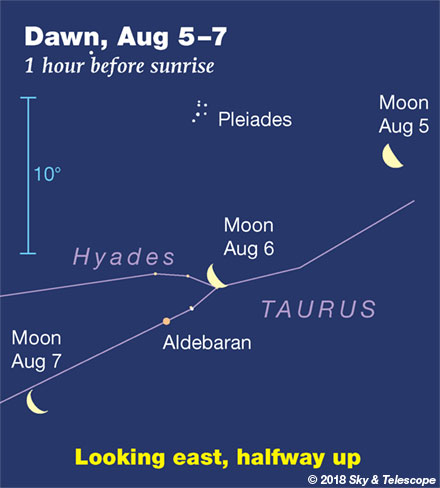
Saturday, August 4
• Last-quarter Moon (exact at 2:18 p.m. Eastern Daylight Time). The Moon rises as late as 2 a.m. tonight, depending on your location. Once it's well up, spot the Pleiades to its left and Aldebaran below the Pleiades. As the very first light of dawn hints at the coming day, you'll find Orion clearing the eastern horizon far below Aldebaran (for the world's mid-northern latitudes).
________________________
Want to become a better astronomer? Learn your way around the constellations! They're the key to locating everything fainter and deeper to hunt with binoculars or a telescope.
This is an outdoor nature hobby. For an easy-to-use constellation guide covering the whole evening sky, use the big monthly map in the center of each issue of Sky & Telescope, the essential guide to astronomy.

Once you get a telescope, to put it to good use you'll need a detailed, large-scale sky atlas (set of charts). The basic standard is the Pocket Sky Atlas (in either the original or Jumbo Edition), which shows stars to magnitude 7.6.
Next up is the larger and deeper Sky Atlas 2000.0, plotting stars to magnitude 8.5; nearly three times as many. The next up, once you know your way around, are the even larger Interstellarum atlas (stars to magnitude 9.5) and Uranometria 2000.0 (stars to magnitude 9.75). And read how to use sky charts with a telescope.
You'll also want a good deep-sky guidebook, such as Sue French's Deep-Sky Wonders collection (which includes its own charts), Sky Atlas 2000.0 Companion by Strong and Sinnott, or the bigger Night Sky Observer's Guide by Kepple and Sanner.
Can a computerized telescope replace charts? Not for beginners, I don't think, and not on mounts and tripods that are less than top-quality mechanically (meaning heavy and expensive). And as Terence Dickinson and Alan Dyer say in their Backyard Astronomer's Guide, "A full appreciation of the universe cannot come without developing the skills to find things in the sky and understanding how the sky works. This knowledge comes only by spending time under the stars with star maps in hand."
This Week's Planet Roundup
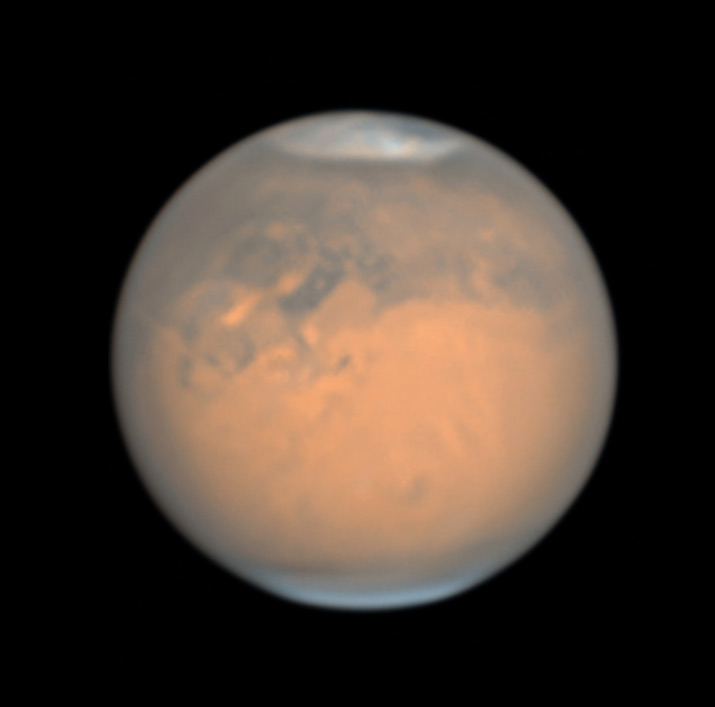
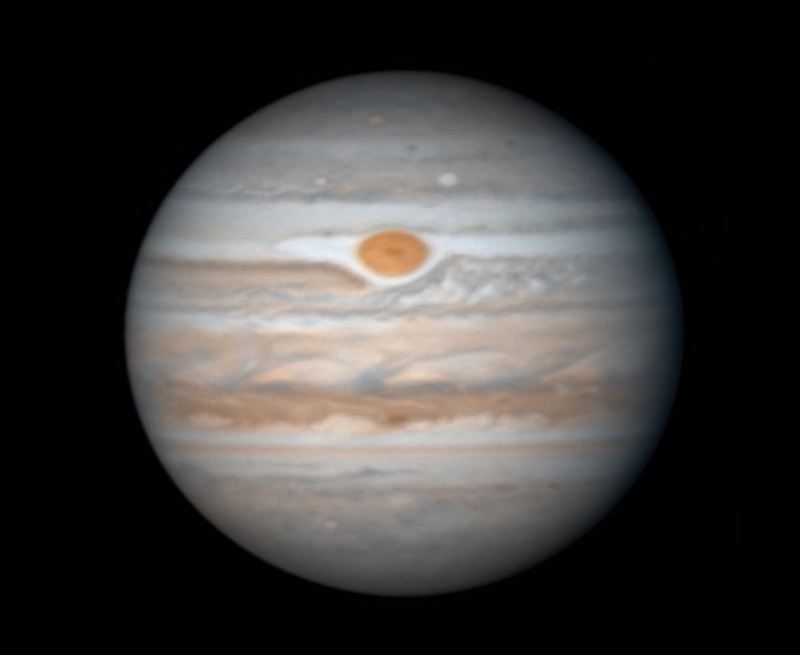
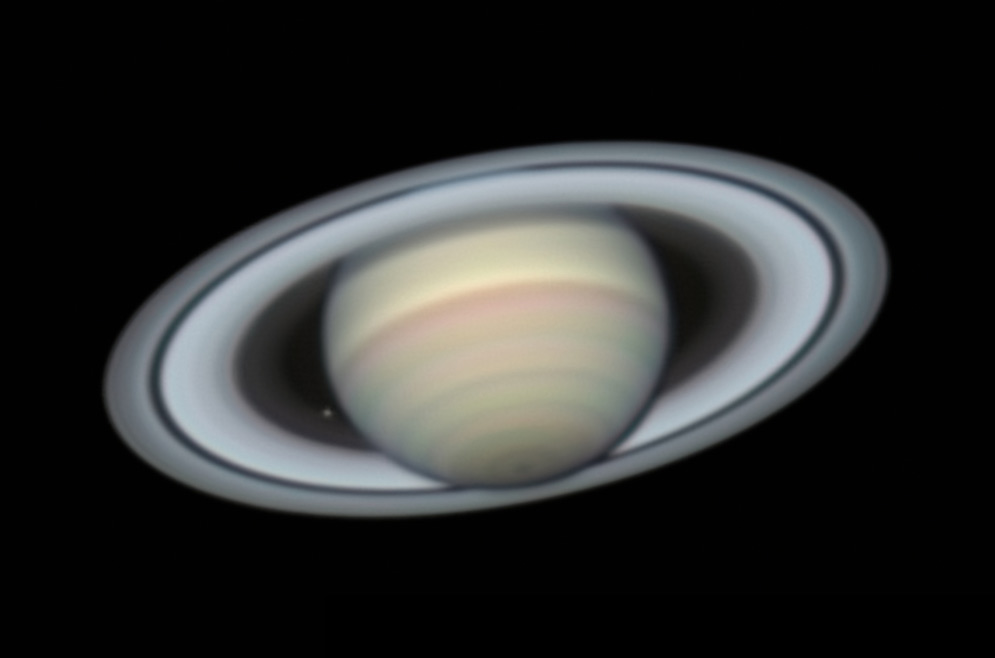
Mercury is hidden in the glare of the Sun.
Venus (magnitude –4.3) shines brightly in the west during twilight, a little lower every week. It sets around the end of twilight. In a telescope Venus is gibbous, 21 arcseconds tall and 57% sunlit.
Mars this week is closer to Earth than it has been in 15 years! It's a firespot blazing at magnitude –2.8, twice as bright as Jupiter. And its color lends it extra drama.
Spot Mars low in the southeast in twilight. After dark it rises higher and shifts southward, a weird anomaly like no celestial object you normally see. Mars is highest in the south, in best telescopic view, around midnight or 1 a.m. daylight-saving time, though it's at a southerly declination (—26°) in southern Capricornus.
Mars is exactly closest on the night of Monday July 30th, showing a disk 24.3 arcseconds wide, but the difference all week is insignificant. Mars was at opposition on the 27th. And a bit of good news for telescopic observers: The dust that still blankets the Martian globe is thinning a little, allowing faint, low-contrast views of some dark surface markings.
Can you identify any of these features? For a Mars map that shows which are facing Earth at your time and date, use our Mars Profiler. And see our backyard astronomer's observing guide: See Mars at Its Best Since 2003.
Jupiter (magnitude –2.1, in Libra) shines in the south-southwest in twilight. It's between Spica about 20° to its lower right, and the head of Scorpius about 20° to its left. Catch Jupiter with your scope in late twilight before it gets low.
Saturn (magnitude +0.1, above the Sagittarius Teapot) glows yellow in the south after dark. It's about 30° to the right or upper right of much brighter Mars. In a telescope Saturn's rings are still tilted 26° to our line of night, nearly as open as we ever see them.
Uranus (magnitude 5.8, at the Aries-Pisces border) and Neptune (magnitude 7.8, in Aquarius) are well placed high in the southeast and south, respectively, in the hour or two before the first light of dawn. Finder charts for Uranus and Neptune.
______________________
All descriptions that relate to your horizon — including the words up, down, right, and left — are written for the world's mid-northern latitudes. Descriptions that also depend on longitude (mainly Moon positions) are for North America.
Eastern Daylight Time (EDT) is Universal Time (also called UT, UTC, GMT, or Z time) minus 4 hours.
______________________
"Remember to look up at the stars and not down at your feet. Try to make sense of what you see and wonder about what makes the universe exist. Be curious."
— Stephen Hawking, 1942–2018
______________________
"The dangers of not thinking clearly are much greater now than ever before. It's not that there's something new in our way of thinking, it's that credulous and confused thinking can be much more lethal in ways it was never before."
— Carl Sagan, 1996
______________________
"Objective reality exists. Facts are often determinable. Vaccines save lives. Carbon dioxide warms the globe. Bacteria evolve to thwart antibiotics, because evolution. Science and reason are not a political conspiracy. They are how we determine facts. Civilization's survival depends on our ability, and willingness, to do this."
— Alan MacRobert, your Sky at a Glance editor
______________________
"Facts are stubborn things."
— John Adams, 1770
 1
1








Comments
misha17
July 27, 2018 at 1:51 pm
The link that you posted for the article, "Red Moon Meets Red Planet in Longest Total Lunar Eclipse of the Century", doesn't work. This is the correct link:
https://skyandtelescope.org/observing/red-moon-meets-red-planet-for-lunar-eclipse/
You must be logged in to post a comment.
You must be logged in to post a comment.